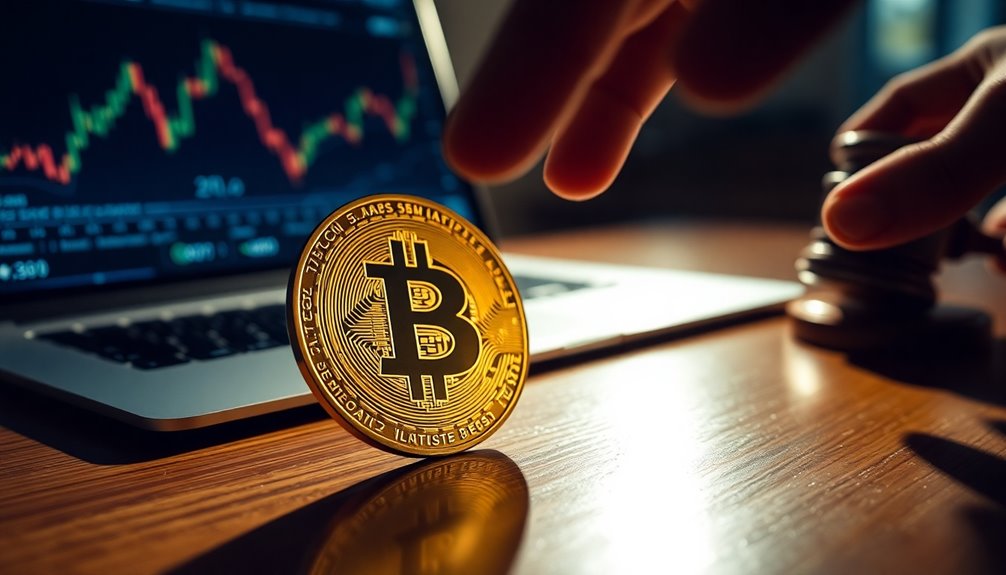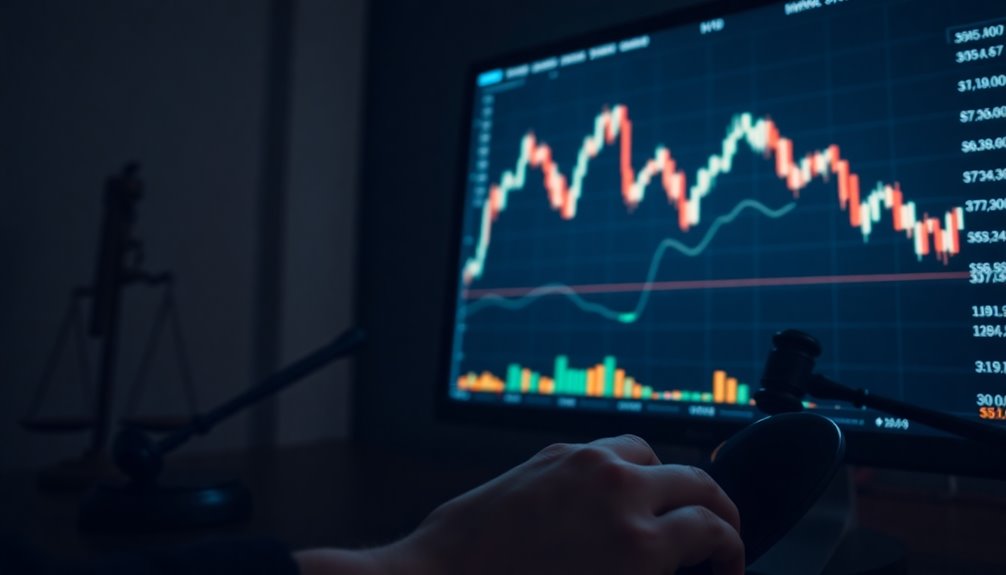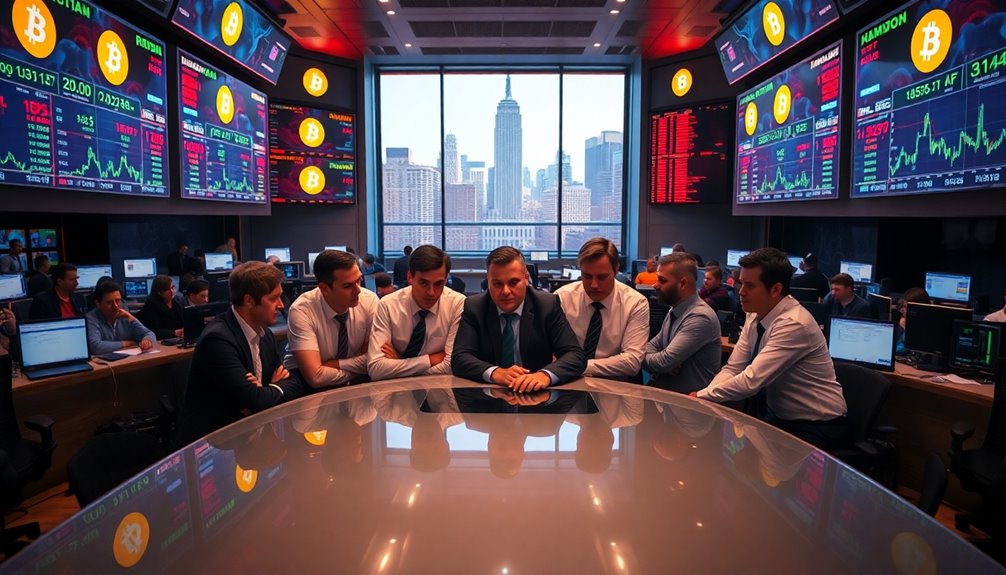The US DOJ's potential sale of over 69,000 Bitcoin could trigger significant price volatility. Historically, regulatory actions have caused sharp market reactions, like China's ban in 2021 leading to a price plunge. If the DOJ's actions create uncertainty, you might see increased sell-side pressure, impacting your investment strategy. However, if the market perceives these actions as regulatory clarity, it could lead to stability and even price increases, similar to past positive regulatory news. Understanding these scenarios can help you navigate your investments effectively—there's more to consider about the intricacies of Bitcoin's price dynamics.
Key Takeaways
- The US DOJ's authorization to sell over 69,000 BTC may create sell-side pressure, potentially leading to price volatility in the market.
- Historical precedents, like the 56,000 BTC sale in July 2024, indicate that large BTC sales can initially drive prices up.
- Market sentiment might react cautiously to the DOJ's actions, balancing optimism with concerns over potential supply increases.
- Regulatory clarity from the DOJ could stabilize long-term investment sentiment, counteracting short-term price fluctuations.
- Monitoring key metrics like NUPL and exchange netflows will be crucial in assessing market reactions to DOJ-related sales.
Key Concepts Overview

Understanding key concepts is essential when analyzing Bitcoin price scenarios, especially given the cryptocurrency's volatile nature. Historical precedents reveal that government BTC sales have varied effects on the market. For instance, the German administration's sale of 56,000 BTC in July 2024 led to a price increase from $53,000 to $68,000. However, significant inflows like those in March 2021 and June 2022 caused corrections and prolonged bear markets. Current market sentiment reflects cautious optimism, which could mitigate sell-side pressure from potential DOJ actions. US DOJ authorized to sell over 69,000 BTC, raising concerns about its impact on market dynamics. Key metrics like NUPL and exchange netflows are vital in assessing reactions to large sales, while technical indicators suggest a potential bearish trend ahead. Understanding these concepts will help you navigate the complexities of Bitcoin's price movements.
Market Reaction to Regulations

Regulatory changes play a pivotal role in shaping Bitcoin's price movements, often causing significant volatility. For instance, when China banned Bitcoin-related activities in April 2021, you saw the price plummet from $64,000 to $48,000. Conversely, positive news, like anticipated Bitcoin ETF approvals, tends to boost prices. Regulatory news heavily influences market sentiment; the SEC's rejection of a Bitcoin ETF in 2017 caused a swift 16% price drop. You'll notice that a defined legal status under light regulation is preferred, while stricter regulations usually elicit negative responses. Ultimately, regulatory certainty fosters investor confidence, encouraging participation and driving prices higher, making it crucial for you to stay informed about these developments. Increased regulatory clarity may contribute to a more stable investment environment, potentially leading to long-term market stabilization. Moreover, understanding risk management strategies is essential for navigating the uncertainties that regulatory changes can introduce.
Mechanics of Bitcoin Transactions

When you engage in Bitcoin transactions, several key processes ensure that everything runs smoothly and securely.
First, you create a transaction by entering the recipient's wallet address and the amount. You then sign it with your private key, confirming your intent to transact.
This signed transaction is broadcasted to the Bitcoin network, where nodes verify its authenticity by checking for sufficient funds and valid signatures. Each transaction is validated by miners, who use cryptographic techniques to ensure its integrity.
Miners then verify the transaction through complex algorithms, forming a block template. After successfully mining a block, it's added to the blockchain, making your transaction permanent.
Transactions require multiple confirmations for security, ensuring they're tamper-resistant and irreversible, which ultimately builds trust in the system.
Pros and Cons Overview

Bitcoin transactions operate within a complex framework that ensures security and efficiency. When the US DOJ sells seized Bitcoin, it presents both pros and cons.
On the positive side, historical sales show the market can absorb large volumes without major price drops, and recent price resilience indicates underlying strength. The sale also clears legal uncertainties and enhances market transparency. Additionally, the DOJ authorized sale of 69,370 BTC reflects the government's ability to execute large transactions without drastically affecting market stability.
However, significant sales may trigger short-term price corrections due to increased supply, and bearish sentiment can further depress prices. Additionally, this action could disrupt pro-crypto policies and create economic implications, especially in a hawkish environment.
Ultimately, understanding these dynamics helps you navigate the potential impacts on Bitcoin's price.
Regulatory Impact on Volatility

As the landscape of cryptocurrency continues to evolve, the impact of regulations becomes increasingly significant in shaping Bitcoin's volatility. Regulatory announcements can trigger immediate price reactions, often unpredictably.
When positive news surfaces, like Bitcoin ETF approvals, you might see a surge in prices and investor confidence. Conversely, negative announcements—such as bans—can lead to sharp declines, as experienced when China imposed restrictions.
Anticipation of regulatory changes also affects prices, creating an environment of uncertainty. Clear regulations can instill confidence among investors, fostering mainstream acceptance and reducing speculative trading. This is particularly important given that limited historical data complicates analysis and understanding of market behavior.
Ultimately, as regulatory frameworks become clearer, you can expect increased stability and potentially less volatility in Bitcoin's market.
Market Manipulation Concerns

While the cryptocurrency market offers exciting opportunities, it also raises serious concerns about market manipulation that can jeopardize investor trust.
You should be aware of tactics like pump and dump schemes, where false information inflates prices before manipulators sell off their holdings, causing a crash.
Wash trading creates a false sense of activity by buying and selling the same asset simultaneously. In fact, 90,408 tokens were flagged for involvement in such schemes in 2023, highlighting the prevalence of this issue.
Spoofing and layering mislead traders with fake orders, while insider trading exploits confidential information for unfair advantages.
Lastly, oracle manipulation can distort token values, leading to significant losses.
Staying informed about these practices is crucial for protecting your investments and navigating the volatile landscape of cryptocurrency.
Institutional Investment Surge

With institutional demand driving significant momentum, the cryptocurrency market is witnessing a remarkable surge in Bitcoin's price. Over $17 billion has flowed into Bitcoin ETFs, including BlackRock's iShares IBIT Bitcoin ETF, showcasing strong institutional confidence. Sovereign wealth funds and pension managers are now adding Bitcoin to their portfolios, which signals a growing acceptance. This influx of institutional capital has created deeper liquidity and a more sophisticated market structure, stabilizing price movements. Additionally, the booming derivatives market, with open interest at $63 billion, supports this upward trend. As institutions tend to hold positions longer and use strategic sizing, they contribute to reduced volatility, making the market more resilient against sudden price swings. Furthermore, approximately 30% of Bitcoin supply is now held by institutional investors, reinforcing their pivotal role in shaping market dynamics.
Diversify Your Cryptocurrency Portfolio

The recent surge in institutional investment has highlighted the importance of a well-rounded approach to cryptocurrency. To mitigate risks and enhance rewards, you should diversify your portfolio. Start by allocating investments across various crypto assets, like 60% in Bitcoin, 30% in stablecoins, and 10% in altcoins. Consider sector diversification too, investing in DeFi, NFTs, and layer 1 protocols to tap into different growth opportunities. Additionally, mix large-cap, mid-cap, and small-cap cryptocurrencies to balance stability and growth potential. This strategy helps manage volatility and reduces the impact of price swings. Furthermore, historical data shows that diversified portfolios yield higher average returns, reinforcing the importance of a comprehensive investment approach. While diversification won't eliminate market risk, it can offer a smoother ride through the unpredictable crypto landscape, enhancing your overall investment experience.
Frequently Asked Questions
How Do DOJ Actions Specifically Affect Bitcoin Mining Activities?
The DOJ's actions can indirectly affect your Bitcoin mining activities by creating regulatory uncertainty.
If they implement stricter regulations, you might face higher operational costs or compliance challenges.
Additionally, any significant changes in the market due to their actions could impact your profitability.
If the sale of seized Bitcoin influences market sentiment negatively, you might see fluctuations in demand for mining, making it crucial to stay informed about regulatory developments and market trends.
What Historical DOJ Actions Influenced Bitcoin Prices Previously?
Think of Bitcoin like a ship sailing through turbulent waters. Historical DOJ actions, like large-scale seizures, have often sent waves crashing against its hull, causing short-term price drops.
When the government liquidates seized Bitcoin, the market feels the chill, with investors panicking and selling off their assets.
Just as storms pass, the market usually stabilizes over time, but those moments of uncertainty can leave lingering ripples in investor confidence and price stability.
Are There Any Legal Precedents Impacting Bitcoin From the DOJ?
Yes, there are legal precedents impacting Bitcoin from the DOJ.
For instance, the seizure and subsequent sale of Bitcoin from criminal cases have historically influenced market dynamics.
You might recall how the DOJ's actions against schemes like BitConnect led to increased scrutiny and reinforced regulatory frameworks.
These cases set important legal standards that shape how cryptocurrencies are treated in the legal system, affecting investor confidence and market behavior.
How Might Public Perception of Bitcoin Shift Due to DOJ Actions?
You might notice a shift in public perception of Bitcoin as the DOJ takes action against illicit activities.
If successful, these efforts can enhance trust in Bitcoin, showing it's not just for illegal transactions.
However, if the public sees increased regulation as burdensome, it could lead to skepticism.
Ultimately, how you interpret these actions will depend on whether you view them as protective measures or restrictive barriers to innovation in the crypto space.
What Role Do International Regulations Play in US DOJ Decisions?
International regulations act like a tightrope, balancing enforcement and cooperation.
When the DOJ makes decisions, it's not just about U.S. laws; it's about how those laws weave into a global fabric.
You'll notice that foreign laws can complicate matters, influencing how the DOJ collaborates with international partners.
If a foreign country's standards differ, it can shift the weight of U.S. resolutions, shaping the outcome of investigations and prosecutions significantly.
Conclusion
So, as the U.S. DOJ takes action, you might expect Bitcoin to crumble, right? Yet, here we are, watching it bounce back like a rubber ball! The irony is that regulations might just be the push Bitcoin needs to attract more institutional investment. Who knew that a little oversight could fuel a surge in interest? Remember, while you navigate this volatile landscape, diversifying your portfolio could be your best bet. After all, nothing says "stability" like a bit of chaos!









